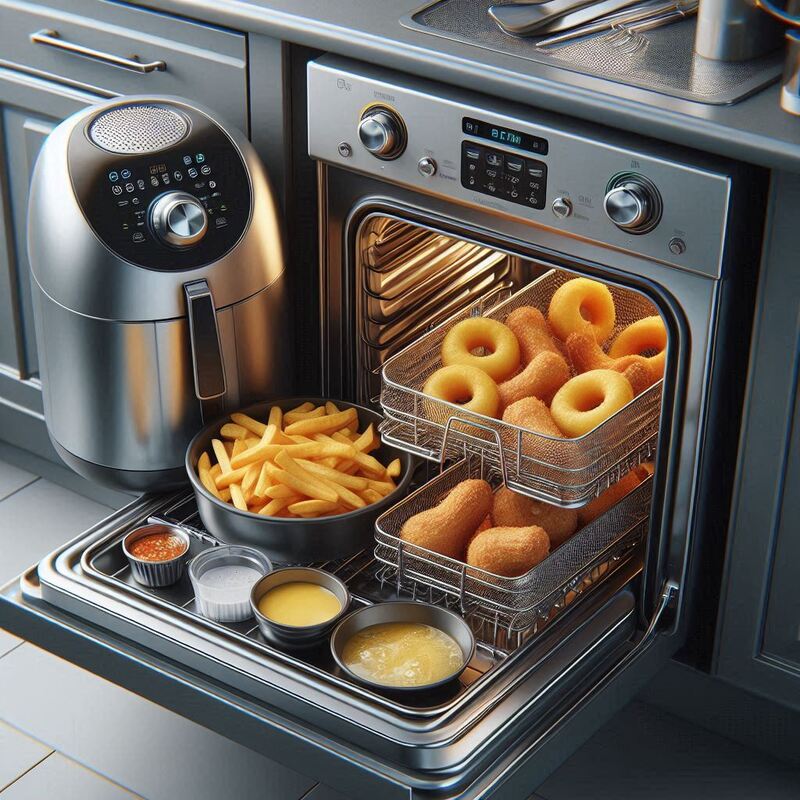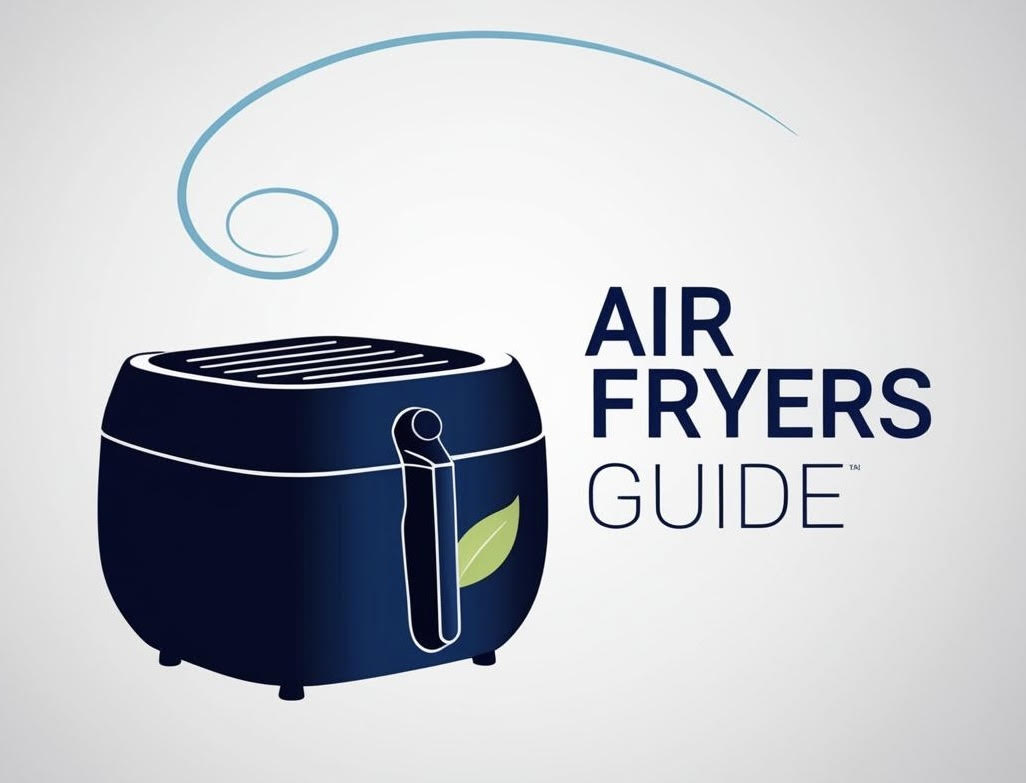Air Fryer vs. Standard Oven: How Do They Compare?

The traditional kitchen oven is the undisputed workhorse appliance, a staple for generations capable of baking, roasting, and broiling large quantities of food. The air fryer, a more recent and popular innovation, promises faster cooking times and significantly crispier results, often with less oil. While both appliances use dry heat to cook food, their methods, speed, capacity, and ideal applications differ significantly. Let's look at how a dedicated countertop air fryer stacks up against your standard conventional (non-convection) kitchen oven.
How They Work: Radiant Heat & Natural Convection vs. Forced Convection
The primary difference in how these appliances cook food lies in their air movement:
- Standard Oven: Primarily uses radiant heat emitted from heating elements (usually located on the top and/or bottom of the cavity) and relies on natural convection, where hot air rises and circulates slowly within the large cooking chamber. This is a slower, gentler heating process.
- Air Fryer: Utilizes a concentrated heat source (usually a heating coil near the fan) and a powerful, high-speed fan to circulate hot air rapidly and intensely around the food in a small cavity. This method, known as forced convection, cooks food much faster and creates a more pronounced, even crispy effect on the surface.
This difference in air circulation (passive/slow in a standard oven vs. active/fast in an air fryer) is what leads to their differing strengths and weaknesses.
Key Differences Explained
Here's a breakdown of the crucial distinctions between air fryers and standard conventional ovens:
Cooking Method & Results
- Air Fryer: Focuses intense hot air directly around the food, leading to rapid surface browning and exceptional crispiness by quickly dehydrating the exterior, effectively simulating frying with less oil. Excellent for achieving a 'fried' texture on things like wings, fries, and breaded items.
- Standard Oven: Provides a more even, but significantly slower, heating environment due to less effective air circulation. It's ideal for baking items that need to rise uniformly (like cakes or bread), roasting large items, and cooking multiple dishes at once. Browning is slower and overall crisping is much less intense than what an air fryer can achieve.
Speed & Preheat Time
- Air Fryer: Heats up extremely fast (usually under 5 minutes to reach cooking temperature) and cooks most foods in significantly less time – often 1/3 to 1/2 the time of a standard oven – due to the intense airflow and much smaller cooking cavity.
- Standard Oven: Requires a considerably longer preheating time (often 10-15 minutes or more, sometimes longer for higher temperatures) and cooking times for most dishes are generally much longer.
Size & Capacity
- Air Fryer: A compact countertop appliance, designed specifically for cooking small batches or 1-4 servings depending on the model's capacity (typically 1-8 quarts for basket styles, or small oven styles). Its usability is limited by the size of its basket or racks.
- Standard Oven: A large, built-in appliance with a spacious cavity capable of holding multiple baking sheets, large roasting pans, or several dishes simultaneously. Essential for feeding families or crowds and cooking large items.
Energy Usage
- Air Fryer: More energy-efficient for cooking small quantities of food because it heats a much smaller space for a shorter period of time. Using a large oven for a small task like baking two chicken breasts is far less efficient.
- Standard Oven: Uses considerably more energy to heat up and maintain temperature in its large cavity, making it less efficient for small cooking tasks.
Versatility
- Air Fryer: Excels specifically at rapid crisping, reheating crispy foods (see reheating tip), and quick cooking of smaller items. Its limited size makes it less versatile for traditional large-scale baking (cakes, loaves of bread) or roasting large cuts of meat.
- Standard Oven: A highly versatile kitchen workhorse for baking, roasting, broiling, and cooking large volumes of food. Less effective at achieving intense, rapid crisping compared to an air fryer unless using a convection feature (which a standard oven doesn't have) or very high temperatures.
For comparisons involving convection, see Air Fryer vs. Convection Oven. For other comparisons, see Air Fryer vs. Deep Fryer or Air Fryer vs. Microwave.
Air Fryer vs. Standard Oven: Quick Comparison Table
Here's a summary of the main differences:
| Feature | Air Fryer | Standard Oven |
|---|---|---|
| Cooking Method | Forced Convection (intense) | Radiant Heat & Natural Convection (gentle) |
| Primary Result | Aggressive crisping, very fast cooking | Even heating, versatile baking/roasting |
| Size/Capacity | Small (1-8 qt, or small oven style), 1-4 servings | Large, multiple dishes/large items |
| Speed | Very fast preheating & cooking | Slower preheating & cooking |
| Oil Used | Minimal (tablespoon or less) | Depends on recipe (can be significant for roasting) |
| Energy Usage (for small tasks) | High Efficiency | Low Efficiency |
| Versatility | Specialized (crisping, quick cook small items) | General Purpose (baking, roasting, large items) |
Our Air Fryer Cooking Times Chart and general Air Fryer Tips can help you adapt oven recipes.
When to Choose Each Appliance
Knowing when to use your air fryer versus your standard oven depends on the food you're cooking, the quantity, and your desired result:
- Choose the Air Fryer for:
- Single servings or small batches of food you want specifically crispy (like french fries, chicken wings, breaded items, snacks/appetizers).
- Reheating leftovers where you want to bring back the crispy texture (pizza slices, fried chicken, etc.).
- Quickly cooking proteins for 1-2 people (like chicken breast, salmon fillets, steak, pork chops).
- Roasting small amounts of vegetables quickly (see veggie recipe).
- Efficient cooking of frozen convenience foods for best texture.
- Components for meal prep when batch cooking proteins and veggies.
- When you want to avoid heating up your entire kitchen or use less energy for a small task.
- Choose the Standard Oven for:
- Baking traditional cakes, cookies, bread loaves, or muffins where even heat and rising are important.
- Roasting a whole chicken, large turkey, prime rib, or other large cuts of meat.
- Cooking multiple dishes simultaneously (e.g., casseroles, sheet pan meals for a family).
- Anything requiring a large baking dish, roasting pan, or multiple trays.
- Dishes that require slow, gentle cooking or baking without focusing intensely on surface crisping.
- Cooking for a large family or crowd.
While a standard oven is indispensable for many cooking tasks, the air fryer offers speed and crisping capabilities it simply cannot match, making them excellent companions.
Can an Air Fryer Replace a Standard Oven?
For the vast majority of households and cooking needs, no, a dedicated air fryer cannot fully replace a full-sized standard oven. The significant difference in capacity, the ability to cook multiple items simultaneously, and the versatile functionality needed for traditional baking (like yeast breads or large cakes) and roasting large items mean they serve different, equally valuable roles in the kitchen.
Think of the air fryer as a powerful, speedy supplement to your standard oven, particularly for achieving crispy results and cooking smaller portions efficiently. If you have extremely limited space or rarely cook for more than 1-2 people, a larger oven-style air fryer or a feature-rich air fryer toaster oven might handle *most* of your daily cooking needs, but a full oven is generally still required for larger-scale or more traditional baking/roasting tasks. Our Air Fryer Buying Guide explores these different types.
Conclusion: Complementary Kitchen Workhorses
Air fryers and standard conventional ovens, despite both using dry heat, are distinct appliances with different strengths. The air fryer is a specialized tool designed for speed and achieving superior crispiness on small items with minimal oil. The standard oven is a versatile, high-capacity workhorse essential for traditional baking, roasting large items, and cooking for groups. Understanding their key differences reveals that they are not in competition to replace each other but rather serve as valuable, often complementary, tools in a well-equipped kitchen, each excelling at its specific set of tasks.
